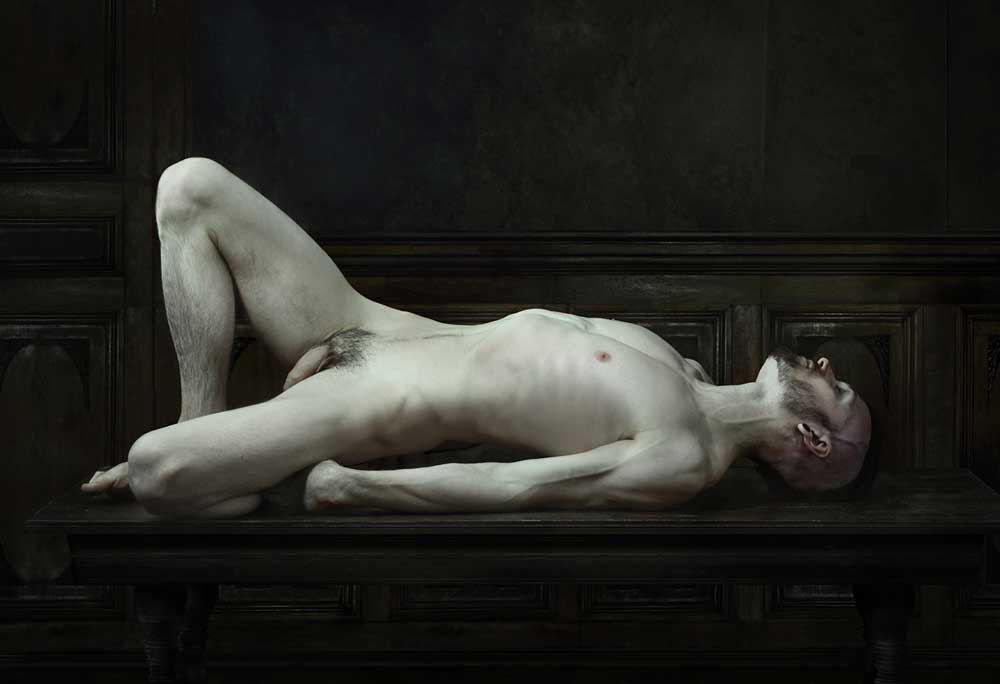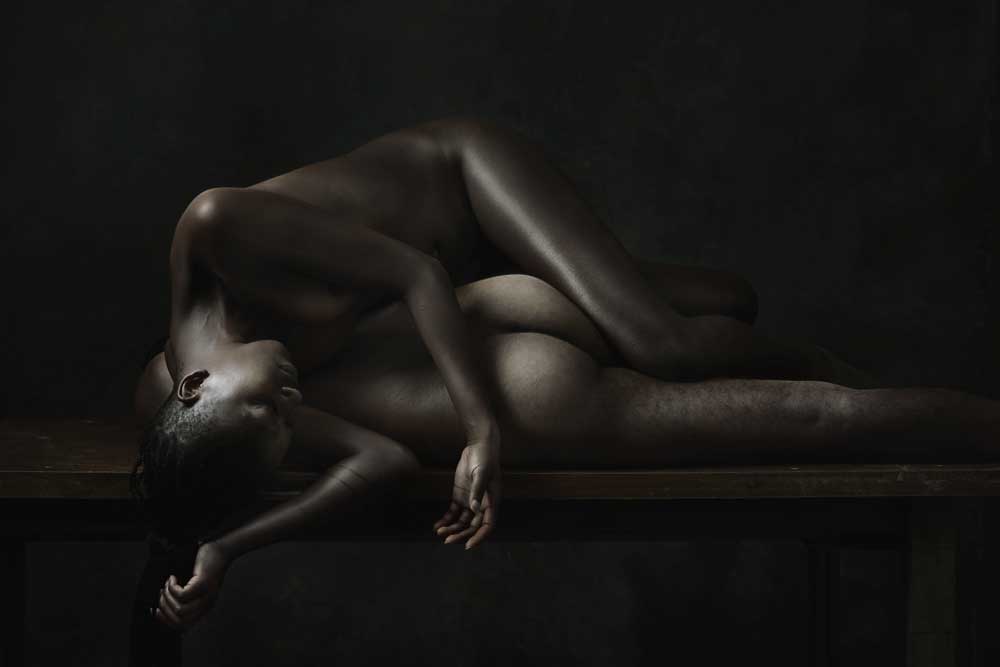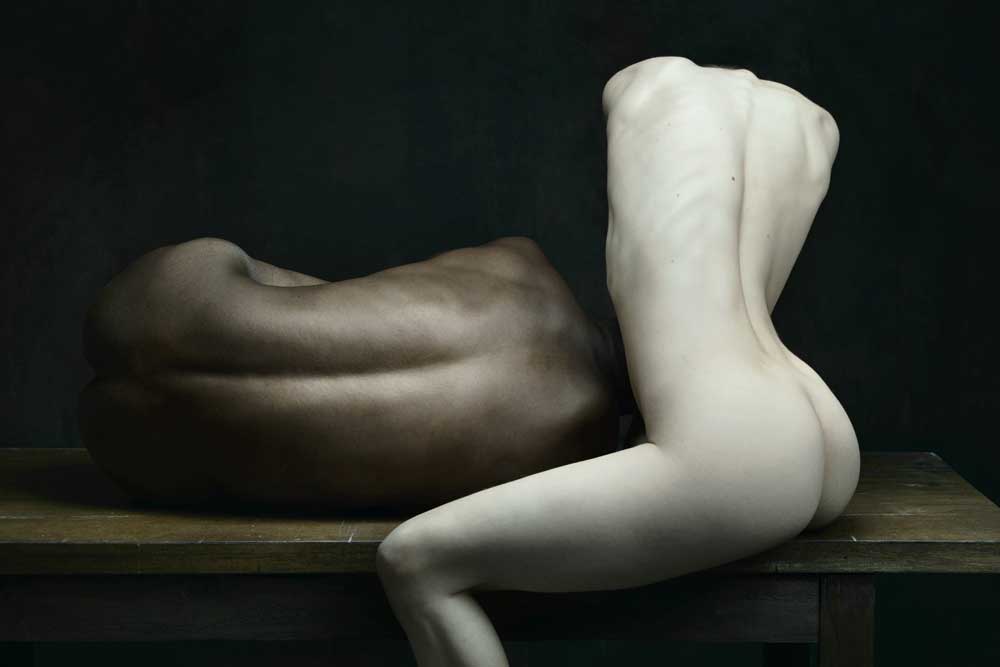From February 5th till March 14th, 2015, OPIOM Gallery is pleased to present Drifting by French photographer Olivier Valsecchi. The series, which will be exhibited for the first time, will feature 10 exclusive photographs and will span his previous series, from Klecksography to Time of War.
Olivier Valsecchi’s new Drifting series is a journey through art history where each picture merges the tradition of the reclining nude with the still life painting genre from Flanders.
Faithfully devoted to his chiaroscuro approach of light, straightforward sense of composition and muted colour schemes, Valsecchi replaces baroque floral arrangements and the overlapping motif of Memento Mori by pale bodies, in order to create what he calls a Flesh Vanitas. His taste for eerie atmospheres draws the viewer into paradoxical tableaux where flowing movement and dumb stillness mysteriously interact.
Every instant devours a piece of the pleasure Granted to every man for his entire season.
Charles Baudelaire, excerpt from The Clock in The Flowers of Evil
While looking at Valsecchi’s Drifting series, obvious images come to mind : sand pouring through the hourglass, Bouguereau’s nudes, or even echoes of Dali’s soft watches as bodies seem to turn into liquid and drip off the table. Their chalky-white, expressionless faces remain silent while sparks of life sift out with the tremor of a leg or the twitch of an arm.
Straying the audience from their grounds of certainty, Valsecchi induces an unsettling doubt on whether his subjects are falling apart or withstanding paralysis. He investigates this tenuous and brooding space between inertia and the urge to go somewhere. His bodies appear to have been submitted to an exor- cism, an epileptic trance, or a mutilation akin to a reptile being cut in two pieces – and yet still crawling. Ultimately, Drifting is to be perceived as a conversation between Rembrandt’s Anatomy Lesson of Dr. Nicolaes Tulp and Géricault’s Raft of the Medusa. The table is alternately a canoe adrift on the open sea or a cold buffet offering souls in transit. Tainted with a surreal aura, it depicts the unutterable moment of confusion when a specific sequence is intriguingly and subconsciously connected to the next. Valsecchi’s comment is that Drifting is a mediation between his previous painterly I am Dust project, and sculptural Klecksography series. « Still-life was the perfect fit for a post-war atmosphere. Beyond symbolizing the ephemeral nature of life, it relates to the notion of transitioning. I wanted to set bodies into an unfamiliar environment and infuse them with a feeling of disorientation, as if recovering from trauma or stuck in a vertigo. »
Drifting is an invitation to meditate at a mystical onirism, a haunting and cryptic gateway between near- death-like experience and the very next minute.
Olivier Valsecchi was born in Paris in 1979. He currently lives and works in Toulouse. Olivier Valsecchi initially studied music as a teenager. As he began creating cover art for his record sleeves, he became passionate and engrossed by photography. He then spent the next ten years taking self portraits for his own enjoyment and mastering his skills upon entering the ETPA photography school, to perfect his technical skills. His work is dark and mysterious, oozing the magic of nature, and uniquely repre- sents the peculiar cycle of birth, death, and rebirth. As a way to translate his emotions, he uses others’ bodies to convey his trance and compose pictures that he qualifies as self-portraits, although he doesn’t necessarily physically appear on the photos. He finds his whole working system, from visualizing a certain image to capturing the moment, to be based on his personal instinct. With his striking black and white images and almost statuesque models, Valsecchi’s work truly brings beauty and character to aspects of life that are rarely thought of as alluring.
From Korea to New York, his work never ceases to arouse the interest of the international press (Ré- ponses Photo, FR; Le Figaro Beaux-Arts, FR; Le Monde, FR; Orlando Weekly, US; Santa Fe Art Magazine, BR; Eyemazing, ND; Zoom, IT; Rooms, UK; Blink, KR; Arte Fotografico, ES; Image in Progress, IT; Profifoto, DE; etc.) as much as that of curators (Promenades Photographiques de Vendôme, Festival Européen de la Photographie de Nu en Arles, Fotofever Paris and Brussels, Centre Atlantique de la Photographie in Brest). More in Dodho Magazine









